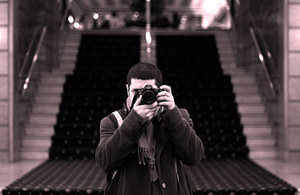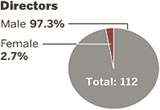The Future of Journalism Is Written in Neon
The salvation of journalism rests with young people who are talented, ambitious, intelligent, obsessive and crazy enough to jump into what is rapidly becoming a low-paying, insecure business.
My search for the I.F. Stone of the 21st century took me to the campus of the University of Southern California and the highly energized office of the Web-based news operation Neon Tommy, sponsored by USC’s Annenberg School for Communication & Journalism.
The university, long shackled with a reputation for conservatism, might be considered an odd place to look for a potential successor to Stone, a crusading liberal journalist ostracized by the mainstream media during the Cold War who nevertheless broke major stories in his own I.F. Stone’s Weekly. But USC is changing. And even the old conservative USC produced progressives such as my personal hero, Carey McWilliams, who was editor of The Nation from 1955 to 1975. Truthdig’s editor, Robert Scheer, is on the Annenberg faculty.
I wanted to talk to some of the Neon Tommy staff because I think that the salvation of journalism rests with young people who are talented, ambitious, intelligent, obsessive and crazy enough to jump into what is rapidly becoming a low-paying, insecure business. As Alan Mutter said of young journalists in his Reflections of a Newsosaur blog, “The starving-artist lifestyle may be colorful and appealing for a while, but it gets old fast if you are bunking on a friend’s sofa, living under the same roof you did in junior high and lying awake at night wondering how you are going to repay your staggering five-figure student loan.
“If nothing changes, the next generation of journalists will give up and move on to entirely different pursuits. And you can’t blame them.”
I got a much more hopeful view when I visited with three students on the Neon Tommy staff, Callie Schweitzer, Olga Khazan and Kevin Grant.
“Nothing is going to stop me,” said Schweitzer, Neon Tommy’s incoming editor. “Yes, there will always be obstacles. That is in every facet of your life, in your job, your personal life, your health. Obstacles are just things you overcome with the help of friends, family and co-workers.” Or, as Khazan said, “I know they [obstacles] are there. I think new business models will emerge, and we will find some way to weather through it. I don’t have the solution. I don’t think anyone has the solution.” Grant said the pessimists’ view is “a lot of bullshit. They’re talking about it, we’re doing it right now. If you’re not doing it, you don’t have a right to talk about it.”
I smiled. I was once like that. Nothing was going to stop me either.
The name Neon Tommy is derived from Tommy Trojan, a campus symbol, and neon, a retro kind of word that invokes the days of neon lights, Rosalind Russell and Cary Grant in “His Girl Friday” and newsboys screaming “Extra!”
The evocation of an earlier era is perfect, for Neon Tommy combines the best in the new multimedia journalism with intensive reporting, clear writing and speed in stories on politics, government, culture, sports and whatever else interests its staff. It also recalls a touch of “The Front Page,” the old newspaper play upon which the film “His Girl Friday” was based.
“We have a lot of people with different interests, and sometimes those interests take them to stories that nobody has heard before,” said Khazan.
Neon Tommy looks for news far beyond the campus, filling a void left by the diminished staffs of the Los Angeles Times, suburban papers and local television and radio stations.
That was clear on March 4 when Neon Tommy dispatched 30 reporters to the streets and campuses to cover protests by students, faculty and relatives against the extreme reduction in funding for public education in California and elsewhere.
Filing videos, still pictures and words from Starbucks and their cell phones, the reporters in the field gave a fast and visual report on what was happening on the campuses. In the newsroom, a few staff members posted the incoming stories. Neon Tommy linked to campus and local websites around the country so its readers could see the extent of the protest. “Until we did that, we didn’t know what we were capable of,” said Grant.
After the demonstration, Neon Tommy wanted to know what the major candidates for governor of California would do to save the public education system. Reporters called the offices of Democrat Jerry Brown and Republicans Meg Whitman and Steve Poizner. None of them called back. Neon Tommy called almost every day for a month, each time posting their frustrating result. Finally, Schweitzer wrote, “The lack of response on such a hot button issue is truly appalling. It is proof that putting pressure on politicians for 30 days is to no avail. If the media cannot get answers from the political elite, what are voters to expect?”
I talked to the faculty members who advise Neon Tommy; Marc Cooper, the director; and Alan Mittelstaedt, the managing editor. They said that the Annenberg dean, Ernest J. Wilson III, and the journalism school director, Geneva Overholser, felt the need for such a Web-based news operation to give the students practical experience and showcase their work.
Other journalism schools have news websites. What I like about Neon Tommy is a certain blue-collar sensibility, perfect for the difficult new era when elite high-paid journalists will be pretty much a memory.
“As the old media fades away, our folks are replacing them,” said Cooper.He didn’t seem to mourn the change. Cooper himself has been an outsider journalist who, during the mainstream media’s glory days, didn’t have much respect for those who worked in it. “Is the moral imperative to protect the highest-grade journalists or produce the maximum amount of information in the public interest?” he asked. “This is the democratization of the media — fewer rich people at the top, a bigger base of the pyramid and lower pay.” He added, “Revolutionary periods are very rough until the new regime is consolidated.”
This is unsettling for a mainstream veteran like me. But I know it’s true. The news business is changing fast, but hopefully not for the worse. The new journalists won’t be lifers at places like the Los Angeles Times, The Washington Post and NBC. They’ll have had a variety of jobs. Some of the rookies will be restaurant servers or Starbucks baristas part of the time, just as actors are now. When they get full-time jobs, their bosses at websites, newspapers and broadcast stations may be the same kind of stupid tyrants you find in too many places today.
But the most talented, ambitious and lucky will survive. There are a few of them right now on the campuses of USC and many other colleges, and some not in college, getting ready to follow the difficult path of I.F. Stone from the bottom to the heights — not in pay, but in public service.
Your support matters…Independent journalism is under threat and overshadowed by heavily funded mainstream media.
You can help level the playing field. Become a member.
Your tax-deductible contribution keeps us digging beneath the headlines to give you thought-provoking, investigative reporting and analysis that unearths what's really happening- without compromise.
Give today to support our courageous, independent journalists.




You need to be a supporter to comment.
There are currently no responses to this article.
Be the first to respond.